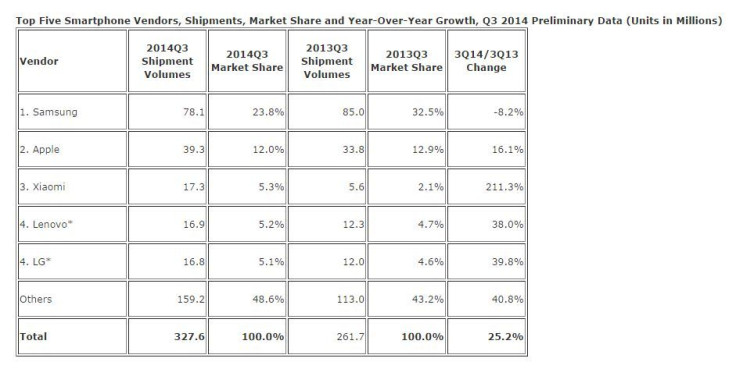Samsung, Apple Lead Worldwide Smartphone Market In Q3 While China’s Xiaomi Enters Top 3

Fresh products and the combined effort of new entrants helped worldwide smartphone shipments surpass 300 million units in the third quarter of 2014. The latest numbers, released by International Data Corporation, or IDC, suggest that the domination of Samsung and Apple in the smartphone market is at stake.
Although Samsung remained the market leader in the three-month period ending in September, the South Korean conglomerate was the only company among the top five smartphone vendors to suffer an annual decline in shipment volume. While Apple had a modest 16 percent growth in the third quarter over the same period last year, the remaining three vendors in the top five served as the main driving force behind the quarter's record volumes.
“The next three vendors – Xiaomi, Lenovo, and LG Electronics – all posted market-beating growth and with markedly different strategies,” Ramon Llamas, a research manager at IDC, said in a statement. “This shows that there is still room to compete in this market, whether it be in the low end as Lenovo has done, at the high end where Xiaomi competes, or in both as LG Electronics has shown. Beyond the top five, there are a number of other vendors achieving similar results.”

IDC attributed the drop in Samsung’s smartphone volume to a constant increase in competition and a slide in demand for its high-end devices, which the company has long relied on.
According to media reports, Samsung saw its July-September quarterly profit fall to the lowest level in more than three years. Samsung said in its earnings statement Thursday that profit for the company’s mobile division fell 73.9 percent to 1.75 trillion won ($1.6 billion) in the third quarter, its worst performance since the second quarter of 2011, Reuters reported.
At Apple, though the company recently posted its largest third-quarter smartphone volume ever, thanks to the release of its highly anticipated iPhone 6 and iPhone 6 Plus, sustained demand for its older iPhone 5S and 5C models made up for the bulk of the company’s overall smartphone volume in the third quarter.
While both Samsung and Apple collectively put up a modest show, China’s Xiaomi entered the top five for the first time at third position.
Thanks to its focus on China and nearby markets, the company enjoyed triple-digit annual growth, according to IDC. The key to Xiaomi’s success was the launch of its Mi4 smartphone in August, which is “a high-end alternative to the status quo,” according to IDC.
Lenovo tied with LG for fourth position with smartphones such as A369i and A316 driving volumes from emerging markets in Asia, the Middle East and Africa. LG, which said that it shipped a record 16.8 million smartphones during the third quarter, found success with its strategy to court markets with low-cost smartphones.
It should be noted that both Lenovo and LG are listed at number four because IDC considers it a statistical tie when there is less than a 0.1 percent difference in the market share (based on shipments) of two or more vendors.
Overall Shipments
According to IDC, worldwide shipments of smartphones added up to 327.6 million units during the third quarter of 2014, a 25.2 percent growth compared to the 261.7 million units shipped in the same period in 2013. The third-quarter shipments of this year also represent an 8.7 percent growth over the 301.3 million units shipped in the second quarter of 2014.
“We've finally reached a point where most developed markets are experiencing single-digit growth while emerging markets are still growing at more than 30% collectively,” Ryan Reith, a program director with IDC's Worldwide Quarterly Mobile Phone Tracker, said in the statement.
© Copyright IBTimes 2025. All rights reserved.






















